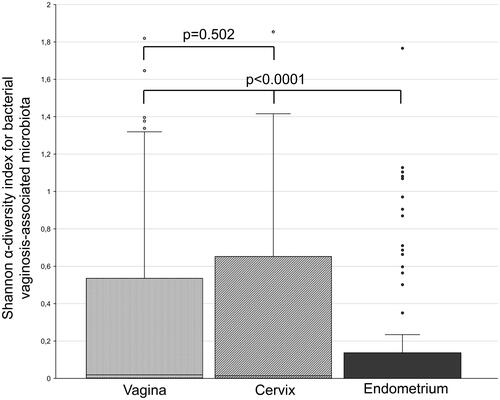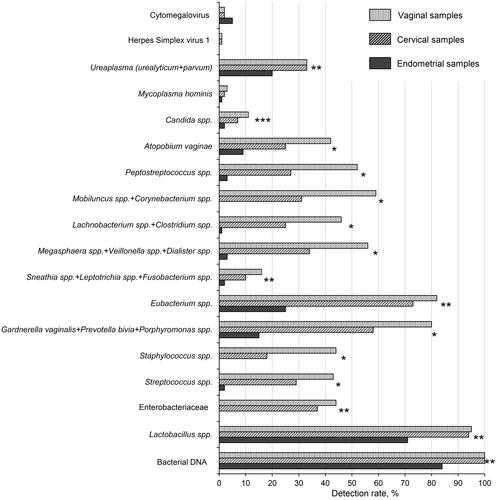Figures & data
Figure 1. Diversity of microbial communities in vaginal, cervical, and endometrial samples of infertile patients. Vaginal, cervical, and endometrial samples were obtained from each study participant (n = 100). The abundances of vaginosis-associated bacteria and fungi were analyzed using a real-time PCR kit ‘Femoflor 16’ (cat# R1-P801-S3/6) (DNA-Technology, Moscow, Russia)), which includes reagents for the detection of 24 relevant bacterial and fungal taxa. The line inside the box represents the median value; the borders of the box – are the first and third quartiles; whiskers – the maximum value before the upper limit (third quartile + 1.5 × interquartile range); circles above whiskers are outliers.

Figure 2. Comparison of detection rates of microorganisms and viruses in vaginal, cervical, and endometrial samples of infertile patients. Vaginal, cervical, and endometrial samples were obtained from each study participant (n = 100). Samples were analyzed using real-time PCR kits ‘Femoflor 16’, ‘TNC Complex’, ‘Herpes Multiplex’ (cat# R1-P801-S3/6, R1-P111-S3/9, R1-P210-S3/9, respectively, (DNA-Technology, Moscow, Russia)). The recommended manufacturer cycle threshold value for qualitative analysis was 24, whereas during quantitative analysis DNA levels of less than 103 copies were considered negative. The detection of bacterial DNA was based on the amplification of a conservative procaryotic sequence. Some closely related taxa were analyzed collectively due to limitations of the applied real-time PCR assay. In such cases, the names of the taxa are listed together and joined by a “+” sign. P-values were calculated using Cochran’s Q test. *significant difference for all types of samples (p < 0.05). **significant difference for endometrial samples vs other types of samples. ***significant difference for endometrial samples vs vaginal samples.

Table 1. Results of comparative quantitative microbiota analysis in vaginal, cervical, and endometrial samples.
Table 2. Clinical and demographic characteristics of the participants.
Supplemental Material
Download MS Excel (51.9 KB)Supplemental Material
Download MS Word (1.1 MB)Data availability statement
Results of microbiological analysis and clinical data of study participants are presented in Supplemental material 2.
